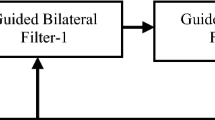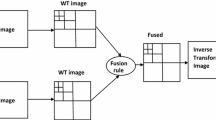Abstract
The fusion of hyperspectral image and panchromatic image is an effective process to obtain an image with both high spatial and spectral resolutions. However, the spectral property stored in the original hyperspectral image is often distorted when using the class of traditional fusion techniques. Therefore, in this paper, we show how explicitly incorporating the notion of “spectra preservation” to improve the spectral resolution of the fused image. First, a new fusion model, spectral preservation based on nonnegative matrix factorization (SPNMF), is developed. Additionally, a multiplicative algorithm aiming at get the numerical solution of the proposed model is presented. Finally, experiments using synthetic and real data demonstrate the SPNMF is a superior fusion technique for it could improve the spatial resolutions of hyperspectral images with their spectral properties reliably preserved.




Similar content being viewed by others
References
Manolakis D, Marden D, Shaw GA (2003) Hyperspectral image processing for automatic target detection applications. Linc Lab 14(1):79–116
Shaw GA, Burke HK (2003) Spectral imaging for remote sensing. Linc Lab 14(1):3–28
Cetin M, Musaolu N (2009) Merging hyperspectral and panchromatic image data: qualitative and quantitative analysis. Int J Remote Sens 30(7):1779–1804
Zhang Y, Hong G (2005) An IHS and wavelet integrated approach to improve pan-sharpening visual quality of natural colour IKONOS and QuickBird images. Inf Fus 6:225–234
Carper WJ, Lillesand TM, Kiefer RW (1990) The use of intensity hue saturation transformations for merging SPOT panchromatic and multi-spectral image data. Photogramm Eng Remote Sens 56:459–467
Gillespie AR, Kahle AB, Walker RE (1987) Color enhancement of highly correlated imagesII. Channel ratio and chromaticity transformation techniques. Remote Sens Environ 22:343–365
King RL, Wang J (2001) A wavelet based algorithm for pan sharpening landsat 7 imagery. In: Proceedings of international geoscience and remote sensing symposium (IGARSS 2001), pp 849–851
Aiazzi B, Alparone L, Baronti S, Garzelli A (2002) Context-driven fusion of high spatial and spectral resolution images based on oversampled multi-resolution analysis. IEEE Trans Geosci Remote Sens 40(10):2300–2312
Chavez PS, Slides SC, Anderson JA (1991) Comparison of three different methods to merge multiresolution and multispectral data: landsat TM and SPOT panchromatic. Photogramm Eng Remote Sens 57(3):295–303
Pellemans A, Jordans R, Allewijn R (1993) Merging multispectral and panchromatic SPOT images with respect to the radiometric properties of the sensor. Photogramm Eng Remote Sens 59(1):81–87
Tu T-M, Su S-C, Shyun H-C, Huang P-S (2001) A new look at IHS-like image fusion methods. Inf Fus 2:177–186
Liu JG (2000) Smoothing filter-based intensity modulation: a spectral preserve image fusion technique for improving spatial details. Int J Remote Sens 21(18):3461–3472
Zhou J, Civco DL, Silander JA (1998) A wavelet transform method to merge landsat TM and SPOT panchromatic data. Int J Image Process 19(4):743–757
Wang ZJ, Ziou D, Armenakis C, Li D, Li QQ (2005) A comparative analysis of image fusion methods. IEEE Trans Geosci Remote Sens 43(6):1391–1402
Pajares G, de la Cruz JM (2004) A wavelet-based image fusion tutorial. Pattern Recognit 37(9):1855–1872
Amolins K, Zhang Y, Dare P (2007) Wavelet based image fusion techniques-an introduction, review and comparison. ISPRS J Photogramm Remote Sens 62(4):249–263
Lee DD, Seung HS (1999) Learning the parts of objects by non-negative matrix factorization. Nature 401:788–791
Jia S, Qian Y (2009) Constrained nonnegative matrix factorization for hyperspectral unmixing. IEEE Trans Geosci Remote Sens 47(1):161–173
Lin CJ (2007) Projected gradient methods for non-negative matrix factorization. Neural Comput 19(10):2756–2779
Lee DD, Seung HS (2001) Algorithms for non-negative matrix factorization. Adv Neural Inf Process Syst 13:556–562
Hoyer PO (2002) Non-negative sparse coding. In: Proceedings of IEEE workshop neural network. Signal process. Martigny, Switzerland, pp 557–565
Helmi Zulhaidi, Mohd Shafri, Affendi Suhaili, Shattri Manso (2007) The performance of maximum likelihood, spectral angle mapper. neural network and decision tree classifiers in hyperspectral image analysis. J Comput Sci 3(6):419–423
Nascimento JMP, Dias JMB (2005) Vertex component analysis: a fast algorithm to unmix hyperspectral data. IEEE Trans Geosci Remote Sens 43(4):898–910
Roberts W, Aardt JV, Ahmed F (2008) Assessment of image fusion procedures using entropy, image quality, and multispectral. J Appl Remote Sens 2:023522
Otazu X, Gonzalez-Audicana M, Fors O, Nunez J (2005) Introduction of sensor spectral response into image fusion methods. Application to wavelet-based methods. IEEE Trans Geosci Remote Sens 43(10):2376–2385
El-Mezouar MC, Taleb N, Kpalma K, Ronsin J (2011) An IHS-based fusion for color distortion reduction and vegetation enhancement in IKONOS imagery. IEEE Trans Geosci Remote Sens 49(5):1590–1602
Chang CI (2000) An information theoretic-based approach to spectral variability, similarity and discriminability for hyperspectral image analysis. IEEE Trans Inf Theory 46(5):1927–1932
Deshmukh M, Bhosale U (2010) Image fusion and image quality assessment of fused images. Int J Image Process 4(5):484–508
US Army Corps Engineers, http://www.tec.army.mil/hypercube/
China Centre for Resources Satellite Data and Application. http://www.cresda.com
Google Map. http://ditu.google.cn/maps
Acknowledgments
The work was supported by the National Natural Science Foundation of China under the Grants 60975003 and 91120301, the 973 Program under the Grant 2010CB327904, the open funding project of State Key Laboratory of Virtual Reality Technology and Systems, Beihang University (Grant No. BUAA-VR-12KF-07), the Program for New Century Excellent Talents in University of Ministry of Education of China under the Grant NCET-11-0775, and the Beijing Natural Science Foundation (nonnegative component analysis for hyperspectral imagery unmixing) under the Grant 4112036.
Author information
Authors and Affiliations
Corresponding author
Rights and permissions
About this article
Cite this article
Zhang, Z., Shi, Z. Nonnegative matrix factorization-based hyperspectral and panchromatic image fusion. Neural Comput & Applic 23, 895–905 (2013). https://doi.org/10.1007/s00521-012-1014-2
Received:
Accepted:
Published:
Issue Date:
DOI: https://doi.org/10.1007/s00521-012-1014-2




